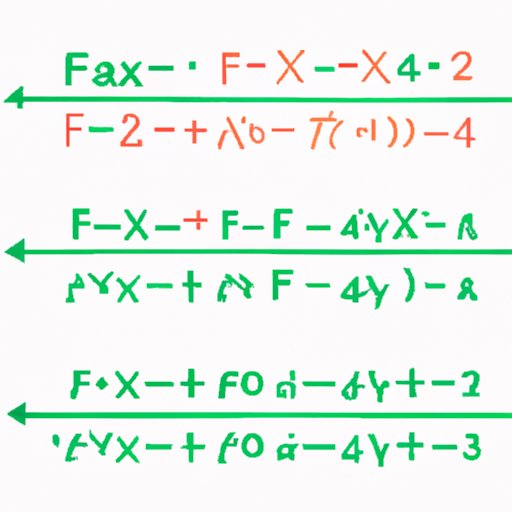Introduction
Factoring trinomials is a fundamental skill in algebra that involves breaking down a quadratic expression into simpler factors. This skill is essential for solving more complex equations and is widely used in a variety of fields, from engineering to computer science. Although it may seem intimidating at first, with practice and patience, anyone can learn how to factor trinomials. In this article, we will explore the step-by-step process of factoring trinomials, common mistakes to avoid, and real-world applications of this skill.
A Step-by-Step Guide to Factoring Trinomials
The first step in factoring a trinomial is to identify the form of the expression. The standard form of a quadratic trinomial is ax^2 + bx + c, where a, b, and c are constants. Once you have identified this form, follow the steps below:
- Find the product of a and c.
- Determine two factors of this product that add up to b.
- Replace bx with these factors in the original expression.
- Factor common terms from the resulting binomial.
- Write the factored form of the expression.
Let’s look at an example. Suppose we want to factor the expression 2x^2 + 7x + 3.
- a*c = 2 * 3 = 6
- The factors of 6 that add up to 7 are 6 and 1.
- Replace 7x with 6x + x.
- Factor 2x + 1 from the binomial 6x + x + 3.
- The factored form is (2x + 1)(x + 3).
It’s important to note that not all quadratic trinomials can be factored using this method. Some require other techniques, such as the quadratic formula. However, the steps outlined here will work for the majority of cases.
Tips and Tricks for Factoring Trinomials
While the basic process of factoring trinomials is straightforward, there are some tips and tricks that can make it easier and more efficient.
- Look for common factors. If the expression contains common factors, these can be factored out before applying the steps listed above. For example, the expression 6x^2 + 15x can be factored as 3x(2x + 5).
- Use the quadratic formula. If the expression cannot be factored using the steps above, you can use the quadratic formula to find the roots of the equation. Once you have found the roots, the factored form can be written as (x – root1)(x – root2).
- Work backwards from the answer. Check your work by multiplying the factors back together and verifying that they produce the original expression. This can also be used as a strategy for factoring trinomials. If you know the factored form, you can expand the expression to verify that it matches the original quadratic trinomial.
By using these techniques, you can save time and reduce errors when factoring trinomials.
Factoring Trinomials in the Real World
While factoring trinomials may seem abstract and theoretical, it has many practical applications in fields ranging from engineering to computer science. For example:
- In engineering, factoring trinomials is used to analyze stress and strain in materials. By factoring the characteristic equation of a material, engineers can predict how it will behave under different loads and conditions.
- In physics, factoring trinomials is used to model the motion of objects under different forces. By factoring the equations of motion, physicists can make predictions about the trajectory and speed of objects such as projectiles.
- In computer science, factoring trinomials is used in cryptography to encrypt and decrypt messages. By factoring large prime numbers, computer scientists can create secure encryption methods that are difficult to crack.
These are just a few examples of how factoring trinomials is used in real-world scenarios. By understanding the underlying concepts and techniques of factoring, you can apply this skill to a wide range of fields and problems.
Common Mistakes to Avoid When Factoring Trinomials
Even experienced mathematicians can make mistakes when factoring trinomials. Here are some common errors to watch out for:
- Misidentifying the form of the expression. Make sure you are dealing with a quadratic trinomial before attempting to factor it.
- Forgetting to factor out common factors. Look for opportunities to simplify the expression by factoring out common terms.
- Misapplying the steps. Be sure to follow the steps in order and double-check your work at each step.
To avoid these mistakes, take a systematic approach to factoring trinomials. Write down each step as you go and double-check your work at each stage of the process.
Factoring Trinomials in Context
To gain a deeper understanding of why factoring trinomials is important, let’s explore how it fits into the larger context of math and science.
At its core, factoring trinomials is about solving equations. When we factor a quadratic trinomial, we are essentially finding the roots of the equation. By finding the roots, we can solve for x and obtain a deeper understanding of the underlying relationship between the variables in the equation.
Factoring trinomials is also closely related to other concepts in mathematics, such as graphing parabolas, solving quadratic equations, and working with complex numbers. By mastering factoring trinomials, you will gain a solid foundation in these related areas as well.
Conclusion
In conclusion, factoring trinomials is a fundamental skill in algebra that has many practical applications in fields ranging from engineering to computer science. By following a systematic approach, avoiding common mistakes, and practicing regularly, anyone can master this skill. We hope this article has provided a helpful guide to factoring trinomials and encouraged you to explore this fascinating area of mathematics.
If you would like to practice factoring trinomials further, try out some of the examples and problems on our website. We also recommend checking out the resources provided by your textbook or online algebra courses to deepen your understanding of this valuable skill.
